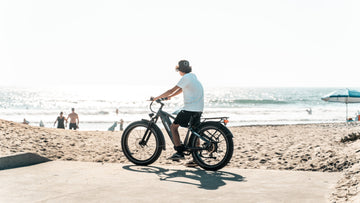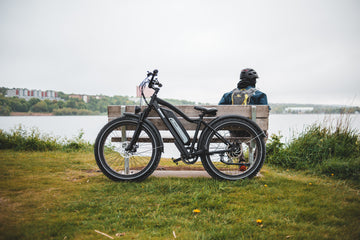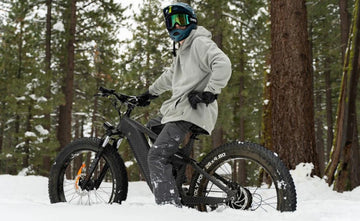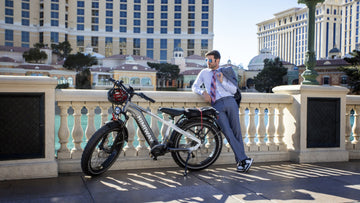Summer is a beautiful time to ride your electric bike. The longer days and warm weather offer perfect conditions for outdoor adventures. However, as temperatures rise, the scorching sun can take a toll on your battery’s health, potentially leading to a shortened lifespan and reduced performance.
To keep your e-bike rolling strong all summer long, it's crucial to understand how heat affects batteries and implement strategies to mitigate its impact. Here are some key steps you can take to ensure your battery stays cool, happy, and ready to power your summer explorations:
Pre-Ride Maintenance During Summer
Fully Charge the Battery Before Riding
A fully charged battery not only ensures maximum performance and peace of mind during longer rides, but it also allows your battery to operate efficiently without straining its cells. While this is a best practice year-round, even when riding your bike in the winter, it's more important during summer as the high heat can worsen its wear and tear.
Additionally, avoid squeezing in a quick charge right before riding; instead, allow the battery to cool down after charging. This cooling period helps prevent it from starting off already overheated. Our Himiway Cruiser has a 720Wh battery capacity with up to 50 miles of range on a single charge. This means you have an efficient operation, minimizing strain on the battery, especially during hot summer days.

Avoid Overnight Charging
Leaving your battery to charge overnight might seem like a smart thing to do, especially when preparing for a long ride the next day. But after fully reaching 100%, some chargers might continue to trickle charge, causing overcharging and excessive heat build-up, which can shorten your battery’s lifespan. Due to this, it is best to schedule a time to charge when you are active. If you only have a few hours of this, you can get a charger that automatically stops after the battery is full or get a fast charger that can get it fully charged in just a couple of hours that you are up.
Charge the Battery Indoors or in a Cool Place
Just as you don’t leave your pet in a hot car, don’t expose your battery to high temperatures, especially when charging. It's often very convenient to charge your electric bike where your battery is stationed, but if the area is hot, you might want to change your charging area. Consider charging your battery indoors in a cool, dry place like your garage or basement. Places like the outdoor, attic, or anywhere there is direct sunlight can trap heat and increase the battery temperature, even at night when you think the air is cool.
Riding Maintenance in the Heat
Reduce Use of High-Power Settings
While we have the Himiway e-bikes fitted with several cool things that make riding fun and easy, they can also be energy-draining, which can heat up your battery if used frequently. Who wouldn’t want to flex the 750w gear hub motor power in their Himiway D5? However, continuous throttling without pedaling, using our high-powered front light, and even high speed can quickly heat up your battery.
While we aren’t saying these items shouldn’t be used, reducing your reliance on them this summer to prolong your battery life. Also, frequent start-stop riding, especially during urban commuting, requires the motor of your e-bike to work harder. Hence, it’s best to plan your ride to enjoy a smoother riding pace.

Monitor Battery Performance
All Himiway e-bikes come with an LCD that displays your battery level and temperature. This could serve as a window into your battery health. Monitoring its performance through the LCD during your rides could give you an idea of when not to push your battery too hard or even let it cool down. Summer can cause your battery performance to fluctuate, but these regular checks can help prevent overheating and potential damage by giving you a heads-up on when to take proactive steps to avoid any issues.
These battery breaks are also a perfect opportunity to grab a refreshing drink from your water bottle holder to rehydrate and take in your surroundings.
Park in Shaded Areas
When you are taking a break for your electric bike to cool off, grabbing refreshments, or taking in the scenery, parking in a little shade goes a long way for your battery. Besides getting your battery cool faster as it's not under direct sunlight, it also prevents it from heating up further, which can cause immediate performance issues and long-term damage.
Finding a shaded spot to park your e-bike during a break isn't just good for your battery – it's a win-win situation! While your battery enjoys relief from the direct sun's heat, you can take a moment to slip off your bike helmet and cool down as well.
How Best to Store Your Battery During Heat
You’d be wrong if you think your battery is safe because you don’t plan on riding your electric bike in the summer. Poor storage can cause permanent damage or even reduced performance, which is why following these steps during summer storage is important.
Clean the Battery and Connectors
Before storing your battery, take a moment to clean your battery and connectors with a clean, dry cloth. Avoid using water or any cleaning agents, as they can cause corrosion, which can damage the battery and even lead to poor connection.
With a poor connection, there is a high likelihood of ineffective charging, which can easily cause overheating during use or charging.
Store in a cool Storage
Just like when charging, it’s best to store your battery in a cool, dry place with good ventilation. Ideally, room temperature or temperatures between 200C to 250C (68°F to 77°F) can significantly improve your battery’s life. Since heat fast-tracks the degradation of battery cells, storing in a cool environment with good ventilation helps mitigate that by preventing heat build-up.
Maintain the Battery Level for Storage
Maintaining the correct battery level during storage is also important for your battery’s health and durability. If you’d be away from riding for just a few days or weeks, keep the battery level between 50% and 80%. For a long-term period like months, 50% to 60% would be perfect. Following this will reduce strain on your battery and prevent excessive discharge.
If you can, check the battery levels every once in a while so they don't fall too far from this ideal percentage. A fully charged battery before storing can damage the internal components, while a completely drained one might struggle to hold a charge later.
Conclusion
With these tips, you can be assured of riding in optimal condition throughout the summer. Proper maintenance not only extends the life of your battery but also enhances your overall riding experience. Remember, a well-cared-for battery means more reliable performance and fewer interruptions during your ride.
Our electric bikes’ batteries are high-performance and durable, with some models retaining 80% power even after 1,000 charges. Why not book a test ride today to find the perfect fit for your summer adventures?

FAQs
What if I won't be using my Himiway for a while?
For extended storage periods (months), maintain a battery level between 50% and 60% to avoid strain and excessive discharge. Check the battery level occasionally to ensure it stays within this range.
Do any Himiway electric bikes offer fast charging capabilities?
While not standard on all models, some of our e-bikes like the Himiway Crusier, come with and are compatible with fast chargers that can significantly reduce charging time. Just 7 hours can bring the battery to a full charge.
What kind of battery do Himiway e-bikes have?
Himiway e-bikes use Samsung or LG cells in their batteries. These brands are renowned for their quality and reliability in lithium-ion batteries, ensuring a longer lifespan and better performance compared to other battery types.
The Samsung and LG cells also provide superior energy density, allowing Himiway e-bikes to achieve longer ranges on a single charge. This choice ensures that Himiway e-bikes are equipped with high-quality batteries that are safe, efficient, and durable.
Can I ride my Himiway e-bike in high temperatures?
Yes, you can ride in high temperatures but take precautions to avoid overheating your battery. Reduce high-power settings, park in shaded areas during breaks, and monitor your battery’s performance.

















